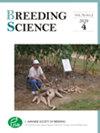水稻穗部维管束数量稳定qtl的鉴定与表征(<i>Oryza sativa</i>)l .)
IF 2.2
4区 农林科学
Q2 AGRONOMY
引用次数: 0
摘要
水稻穗颈维管束数量的增加与种子成熟过程中茎叶向生殖器官运输同化物的能力有关。利用籼稻和粳稻杂交组合获得的分离群体,鉴定了多个VBN数量性状位点(qtl)。然而,qtl在VBN中的具体位置、作用和相互作用尚不清楚。为了阐明VBN的遗传基础,我们利用籼稻“IR24”与粳稻“Asominori”杂交的71个重组自交系,鉴定出了VBN的3个稳定qtl——qvbn5、qVBN6和qvbn11。我们利用具有IR24遗传背景的染色体片段代换系(CSSLs)确定了它们的位置,并对它们的作用进行了表征。qVBN6对VBN的影响最大,其次是qVBN11和qVBN5。我们开发了携带两个qtl的金字塔线用于VBN,以估计它们的相互作用。qVBN6和qVBN11的组合由于各自QTL的独立作用而负向积累VBN。检测到的VBN qtl将有助于加深对VBN遗传机制的认识,并可用于水稻育种。本文章由计算机程序翻译,如有差异,请以英文原文为准。
Identification and characterization of stable QTLs for vascular bundle number at the panicle neck in rice (<i>Oryza sativa</i> L.)
A large vascular bundle number (VBN) in the panicle neck in rice (Oryza sativa L.) is related to the ability to transport assimilates from stem and leaf to reproductive organs during seed maturation. Several quantitative trait loci (QTLs) for VBN have been identified by using segregating populations derived from a cross between indica and japonica rice cultivars. However, the detailed location, effect, and interaction of QTLs for VBN were not understood well. Here, to elucidate the genetic basis of VBN, we identified three stable QTLs for VBN—qVBN5, qVBN6 and qVBN11—by using 71 recombinant inbred lines derived from a cross between indica ‘IR24’ and japonica ‘Asominori’. We confirmed their positions and characterized their effects by using chromosome segment substitution lines (CSSLs) with an ‘IR24’ genetic background. qVBN6 had the most substantial effect on VBN, followed by qVBN11 and qVBN5. We developed pyramided lines carrying two QTLs for VBN to estimate their interaction. The combination of qVBN6 and qVBN11 accumulated VBN negatively in the pyramided lines owing to the independent actions of each QTL. The QTLs detected for VBN will enhance our understanding of genetic mechanisms of VBN and can be used in rice breeding.
求助全文
通过发布文献求助,成功后即可免费获取论文全文。
去求助
来源期刊

Breeding Science
农林科学-农艺学
CiteScore
4.90
自引率
4.20%
发文量
37
审稿时长
1.5 months
期刊介绍:
Breeding Science is published by the Japanese Society of Breeding. Breeding Science publishes research papers, notes and reviews
related to breeding. Research Papers are standard original articles.
Notes report new cultivars, breeding lines, germplasms, genetic
stocks, mapping populations, database, software, and techniques
significant and useful for breeding. Reviews summarize recent and
historical events related breeding.
Manuscripts should be submitted by corresponding author. Corresponding author must have obtained permission from all authors
prior to submission. Correspondence, proofs, and charges of excess page and color figures should be handled by the corresponding author.
 求助内容:
求助内容: 应助结果提醒方式:
应助结果提醒方式:


